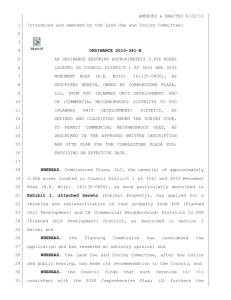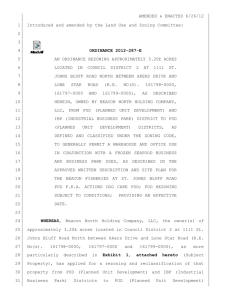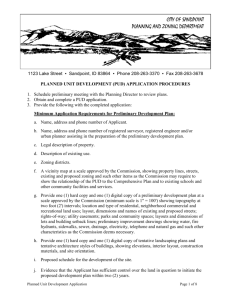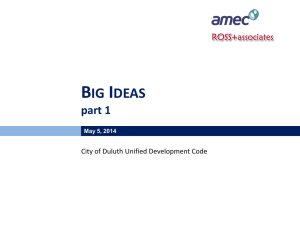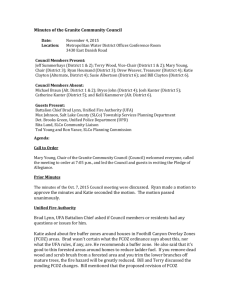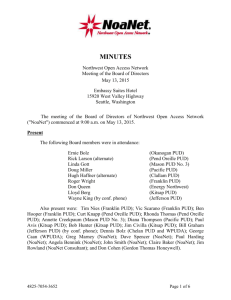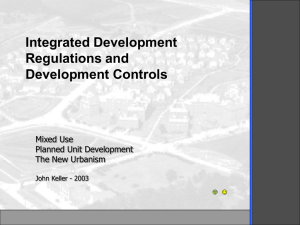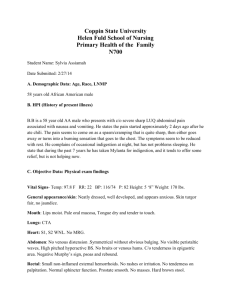Planned Unit Development - Michigan State University
advertisement
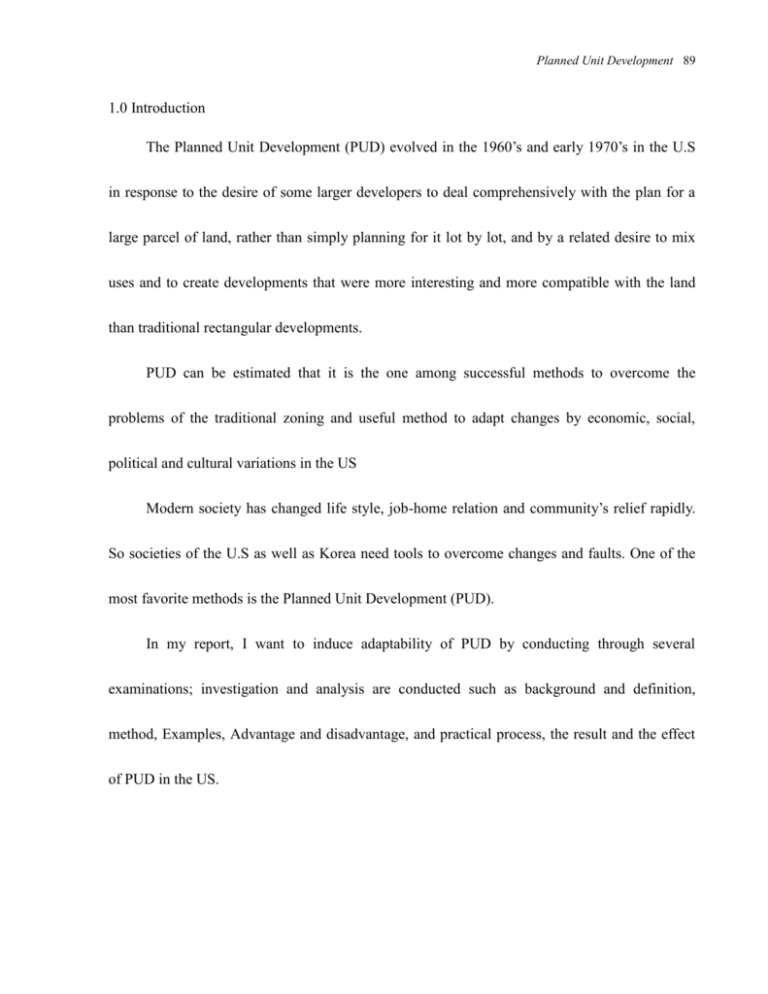
Planned Unit Development 89 1.0 Introduction The Planned Unit Development (PUD) evolved in the 1960’s and early 1970’s in the U.S in response to the desire of some larger developers to deal comprehensively with the plan for a large parcel of land, rather than simply planning for it lot by lot, and by a related desire to mix uses and to create developments that were more interesting and more compatible with the land than traditional rectangular developments. PUD can be estimated that it is the one among successful methods to overcome the problems of the traditional zoning and useful method to adapt changes by economic, social, political and cultural variations in the US Modern society has changed life style, job-home relation and community’s relief rapidly. So societies of the U.S as well as Korea need tools to overcome changes and faults. One of the most favorite methods is the Planned Unit Development (PUD). In my report, I want to induce adaptability of PUD by conducting through several examinations; investigation and analysis are conducted such as background and definition, method, Examples, Advantage and disadvantage, and practical process, the result and the effect of PUD in the US. 90 LAND AND COMMUNITY DEVELOPMENT 2.0 Definition, Background and Development 2.1 Definition PUD is both a physical and a legal concept. Projects developed by this concept usually have a variety of housing types or land uses, open space or facilities to manage the commonly owned elements. PUD also is clearly an outgrowth of cluster housing. However, PUD establishes a broad legal framework for review and approval of development. PUD presents a substantive alternative to the use of traditional zoning regulation and can be adapted to the development of commercial and industrial uses as well. Because PUD have appeared many various types and had significant difference according to each local area, magnitude of area, use of purpose etc, it is very difficult to define what it is and how it does simply. Even though that, PUD can be defined simply as Planned Unit Development (PUD) is a type of planning approval which provides greater design flexibility by allowing deviations from the typical development standards required by the Zoning Code. The intent is to encourage better designed projects than can sometimes be accomplished through compliance with all development requirements, in exchange for providing greater benefits to the community. Also one of famous definitions of PUD is offered by Rober W. Burchell in Rutgers University said that PUD is a means of land regulation which promotes large scale, unified land Planned Unit Development 91 development, realizable programs in pursuit of physically-curable, social and economic deficiencies in peripheral land and cityscape. Where appropriate this development control advocates: A mixture of both land uses and dwelling types, one or more of the nonresidential land uses being regional in nature; The clustering of residential land uses providing public and common open space, the latter to be maintained for and by the residents of the development; Increase administrative discretion to a local professional planning staff while setting aside preset land use regulations and rigid plat approval process; and The enhancement of the bargaining process between developer and municipality thereby strengthening the municipality’s site plan review function and control over tempo and sequence of development in return for potentially increased profits available to the developer as a result of land efficiency, the employment of multiple land uses, and increased residential densities. 2.2 Background PUD ordinances have been used for many years to allow more creative approaches to development. Often embodied as part of the local zoning, they increase flexibility in the design and sitting of development. 92 LAND AND COMMUNITY DEVELOPMENT After New York City adopted a comprehensive zoning ordinance in 1916, this system of land use control became popular in most areas of the US. Zoning constituted a system of regulation on a lot-by-lot basis. The single lot focus was prompted by a desire of local n and for a set of predetermined, self-executing regulations. During the 1920s and 1930s, zoning seemed the ideal solution to most land use and conflicts. But zoning did not solve clearly problems associated with land use and development such as when and where particular types of development would or should occur, the inflexibility of exclusive-use districts, transition from one segregated use to another and the pace of development accelerated in response to the enormous housing demand following the end of World War II. The traditional zoning has no flexibility and adaptation according to changing economic and social environment and then sometimes deprives the site designer of freedom of design since the rigidity of conventional zone. So Planned Unit Development (PUD) ordinance, mixed-use zoning, and other flexible zoning ideas that emerged in the 1960s and 1970s allowed local communities to relax single purpose zoning and permit a mix of uses. These new approaches, reflected in both redevelopment plans and large scale planned communities, resulted in large scale planning and development of multiuse environmental. Namely there appeared new innovative zoning and Planned Unit Development 93 methods. Until 1973, 100 Planned Unit Development ordinances in 32 states across the US are made and 60% of which had been adopted since 1966. Almost all of States in US have PUD ordinance now. 2.3 Factors of Inducing PUD There existed many factors that contributed to bring about PUD. The factors include the followings; Development of consumer preferences for housing variety and amenities Recognition that typical zoning and subdivision control were often inadequate in controlling large-scale development and did nothing to encourage high quality and innovative in such development. Growth of the homebuilding business as a result of extensive development. Abatement of the shortage of the postwar. Enactment of the National Housing Act (1961), The economics’ of PUD : municipalities uses PUD as a method of obtaining desirable amenities for the community such as open spaces and recreational facilities in rapid population growth of suburban area The growth of environmental consciousness and concern 94 LAND AND COMMUNITY DEVELOPMENT 3.0 Practice, Process, and Example of PUD 3.1 Practice of PUD PUD existed diverse types in many cities, PUD provisions are a part of the zoning ordinance, although they also can be a part of the subdivision regulations or exists as a separate ordinance. So PUD conducted under the law of local government where a project is existed. A. General objectives of PUD The goals and objectives of PUD can be changed depending on the location of the projects, size, and the particular public and private sectors involved in the process. The general objectives of PUD can be classified into five issues: i. Flexibility in development standards ii. Encouragement of innovative housing types and products. iii. Provision of increased amenities. iv. The role of negotiation and improved public regulation of development v. To a extent, Providing of affordable housing in some communities. B. Flexibility in PUD Examples of the types of zoning deviations which can be allowed through the PUD process include: Planned Unit Development 95 Allowing uses not listed as permitted, conditional or accessory by the zoning district in which the property is located, Modifying lot size and width requirements, Reducing building setbacks from property lines, Altering parking requirements Increasing building height limits etc. C. General constraints in PUD In exchange for the design flexibility of the PUD, the projects of PUD must demonstrate in the development proposal: does not result in an intensity of land use higher than otherwise allowed, provides public benefits that would not be achievable through the normally required zoning standards, does not create unmitigated traffic impacts, is compatible with surrounding development and environment is consistent with the General Plan of local government. developer cannot request a PUD to increase the number of units allowed in a residential project or decrease the amount of open space or landscaping required. providing adequate access to major thoroughfares, adequate light and air 96 LAND AND COMMUNITY DEVELOPMENT circulation, recreational areas, open space and lot area per dwelling. 3.2 The Process of PUD A. Planned Unit Development Process Even though the each local government has the different process for PUD, the process of PUD can be simply summarized below: i. Pre-Application Conference with Planning Staff and Receive Application forms ii. Applicant completes the application and Submits to Zoning Office for review at that time Zoning distributes copies to Planning Office & Transportation Eng. for review iii. Zoning office returns a corrected copy. Applicant prepares copies & resubmits them to Zoning iv. Zoning Office distributes the copies to various agencies, Planning Board & City Council. And a public hearing is scheduled for Public review. Planning staff shall determine the appropriate review and/or hearing process. v. Planning Board meeting and the public hearing When the property is posted vi. Zoning Office schedules the application for Blueprint Denver Committee of City Council. Meetings are held twice a month. vii. Council Committee meeting. Mayor-Council briefing after Committee. And First Planned Unit Development 97 Reading at City Council. Council Bill is ordered published. Property is posted 21 days viii. City Council hearing. Applicant presents the proposal. City Council votes to approve or deny. B. Characteristics in the process of PUD The final step is at City Council that favor or oppose your plans for development PUD process requires a public hearing usually. After received PUD, developer may need other permits, such as a building permit for new construction or building modifications, a business license A Planned Unit Development expires if it has not been used within destinated duration of the approval date by beginning construction of the project. An approval of PUD may be attached conditions to improve the benefits of local and should comply with Conditions of Approval. Often these conditions must be met prior to building permit issuance. In many cases, At least minimum percent of the land area will dedicated or reserved as usable common "outdoor living" and " open space" land in residential, recreational, or combination residential-commercial development, exclusive of required streets. 98 LAND AND COMMUNITY DEVELOPMENT Prior to preparing a preliminary plan of partition or subdivision, the developer or owner should discuss the proposed division with the City Planner. The developer and the Planner should discuss the implication of the zoning; availability of water and sewer service; street construction requirements; topography of site; and all other factors affecting the division of the property. It is possible and required that in almost all situations, advisable to meet with neighborhood groups and adjacent property owners during the development of your plans and/or PUD application before meetings should definitely occur prior to any public hearings on the matter. To gain approval of project plans from City Council, making favorably many sides (the Planning Board, Council persons, and residents) is important. The entire PUD application process form beginning to end can take many months. C. Materials required for PUD Application Usually submit the following materials to the Planning Division etc to permit PUD project: A complete application form, signed by the applicant and the property owner A written explanation of the proposed use Appropriate Fees. These include the application fee and public notification fee Complete sets of plans: full-sized plans and reduced plans. Planned Unit Development 99 Included in your plans should be: A site plan showing property lines, streets, setbacks, buildings, parking areas, and driveways A floor plan showing how interior spaces of buildings will be used Building elevations of any proposed new buildings or remodeled exteriors A landscape plan if appropriate. A list of people who own property or reside within 300 feet of the boundaries of your property, and one stamped, addressed legal-sized envelope for each person, and an Affidavit of Notification form. 3.3 Examples of PUD Since PUD had many advantage, it gained a popularity many project of PUD have been developed in diverse types and until now. A. The mixed uses of PUD PUD ordinance are oriented toward suburban residential development frequently, allowing flexibility to arrange uses, density, and open space in an innovative plan and often allowing for the creation of areas of more intense mixed uses development. Many of the mixed uses town centers are developed under PUD ordinance such as Reston Town Center, Virginia and Valencia Town Center Drive, California. 100 LAND AND COMMUNITY DEVELOPMENT B. New Mark commons, Rockville, Maryland New Mark commons is a 96-acre PUD, part of the Washington, D.C., metropolitan area. It was conceived in 1965 and its plan included 382 residential units, a small artificially made lake, a community center with a recreational facilities, and a neighborhood commercial center at a gross overall density of 2.97 dwelling units per acre. The 196 townhouse and 186 detached units were completed by 1974. Planned Unit Development 101 The site is compact, hilly, and heavily wooded. As many trees as possible were preserved during construction thus eliminating the need for extensive landscaping. New Mark commons was approved under a PUD ordinance passed by the city in 1964. The ordinance was one of the first in the area and was later used as a model by many other municipalities. 102 LAND AND COMMUNITY DEVELOPMENT C. Martin Sands, Martin County, Florida Martin Sands is the first PUD developed in Martin County and a highly successful workout of a previously unsuccessful recreational community. The 720 acre planned recreational community, which is targeted to active, upper-income retires and semi-retires, is planned to feature the Martin Sands Club with 36 holes of golf, seven tennis courts, a pool center, neighborhood shopping center, and a community chapel. Martin Sands was designed to maintain a low density residential character for the overall community. The specific design characteristics were combined to meet the requirements of the PUD ordinance and the demand of the market. More than 50 percent of the development has remained as open space. Planned Unit Development 103 4.0 Examination of Adaptability of PUD 4.1 Comparison and Contrast in Adaptability of PUD PUD is viewed now an opportunity for development that can benefit both the developer and the community through careful negotiation in the US. Typically, negotiations between developer and the community or planning board, working broad legislative guidelines, help to establish a specific plan. This process can afford developers substantial advantages: higher densities, a more flexible design, savings in construction costs and improved marketability. For a community, the PUD ordinance can offer greater control over development and ultimately preserve open space and reduce costs associated with sprawling development. 104 LAND AND COMMUNITY DEVELOPMENT Even though negotiations between developer and related persons are pre-requisite in many stages of PUD in the US, there are seldom brought up illegal conducts through careful behavior. PUD was introduced as a useful method of development over decades ago in Korea. However, until now, it has been examined only in many parts. There seems to be many reasons: The difference of Legislative system and regulation of land use control. The difference of the magnitude of land, topography, land price and economic conditions. The higher degree of integrity of governmental official and related professional person than the US. Like the case of the US, pre-requisite for the adaptability of PUD such as PUD ordinance needs to gain the popularity of PUD in Korea 4.2 The Possible Adaptable Ways of PUD If the legal and social basement were arranged well in Korea, the several ways that will be useful and effective can be estimated to do, for example; In case of provision, the raw land can be sold in the condition that is not single-use but mixed-uses such as single-family and commercial in the process of Site development. Like the case of Martin Sands development in Florida, residential site development Planned Unit Development 105 for the upper income including golf courses may be possible. So it can give large open space. In developments of preservation and redevelopment zone, PUD including nearby areas could be developed into mix uses. 5.0 Conclusion The Planned Unit Development is an optional procedure for project design, usually applied to a fairly large site. It allows more flexible site design than ordinary zoning by permitting options or relaxing some requirements. A PUD frequently permits a variety of housing types and sometimes other uses as well. Usually PUD includes an overall general plan that is implemented in phases through specific plans As a result of above consideration, PUD can be used as effective methods to benefit both the developer and the community through careful negotiation like the US in Korea if the legal and social basement were provided well As the useful and effective ways, developments of the raw land, residential PUD with golf club and preservation and redevelopment zone etc can be developed by PUD in Korea. 106 LAND AND COMMUNITY DEVELOPMENT Bibliography 1. Contemporary Urban Planning (2005, Sixth Edition, John M. Levy) 2. PUDs in Practice (1985, The Urban Land Institute) 3. Planned Unit Development (1973, Rober W. Burchell)) 4. Mixed use development (2003, Second Edition, ULI) 5. Community Planning (Eric Damian Kelly, 2000) 6. http://denvergov.org/Zoning_Changes/template316363.asp /Colorado 7. http://www.ci.milpitas.ca.gov/citydept/planning/planned_unit.htmPlanned 8. A better way for the Suburbs (1971, ULI) 9. Residential site Development Practice (2000, Korea land corporation) 10. Real Estate Development (2002, Third Edition, Mike E. Miles) 11. Urban Planning (2005, Fourth Edition, Korea land and urban planning association) 12. Many city’s and county’s Zoning ordinance
